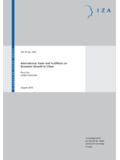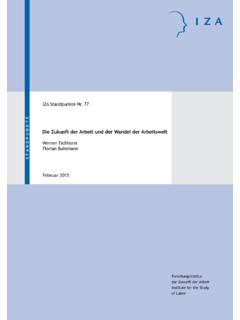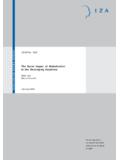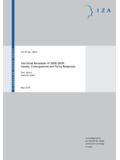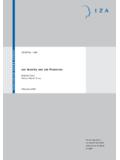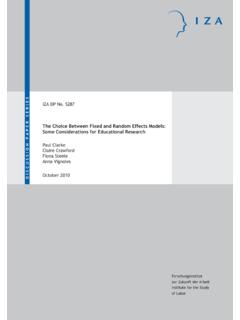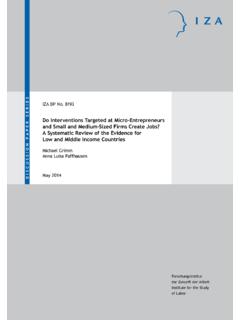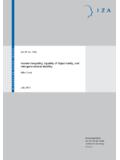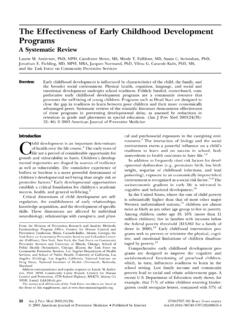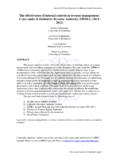Transcription of Activation and Active Labour Market Policies in OECD ...
1 P O L I C Y P A P E R S E R I E SForschungsinstitut zur Zukunft der ArbeitInstitute for the Study of Labor IZA Policy Paper No. 84 Activation and Active Labour Market Policiesin OECD Countries: Stylized Facts andEvidence on their EffectivenessJohn P. MartinJune 2014 Activation and Active Labour Market Policies in OECD Countries: Stylized Facts and Evidence on their effectiveness John P. Martin Geary Institute, University College Dublin and IZA Policy Paper No. 84 June 2014 IZA Box 7240 53072 Bonn Germany Phone: +49-228-3894-0 Fax: +49-228-3894-180 E-mail: The IZA Policy Paper Series publishes work by IZA staff and network members with immediate relevance for policymakers. Any opinions and views on policy expressed are those of the author(s) and not necessarily those of IZA. The papers often represent preliminary work and are circulated to encourage discussion.
2 Citation of such a paper should account for its provisional character. A revised version may be available directly from the corresponding author. IZA Policy Paper No. 84 June 2014 ABSTRACT Activation and Active Labour Market Policies in OECD Countries: Stylized Facts and Evidence on their Effectiveness1 Activation Policies aimed at getting working-age people off benefits and into work have become a buzzword in Labour Market Policies . Yet they are defined and implemented differently across OECD countries and their success rates vary too. The Great Recession has posed a severe stress test for these Policies with some commentators arguing that they are at best fair weather Policies . This paper sheds light on these issues mainly via the lens of recent OECD research. It presents the stylized facts on how OECD countries have responded to the Great Recession in terms of ramping up their spending on Active Labour Market Policies (ALMPs), a key component in any Activation strategy.
3 It then reviews the macroeconomic evidence on the impact of ALMPs on employment and unemployment rates. This is followed by a review of the key lessons from recent OECD country reviews of Activation Policies . It concludes with a discussion of crucial unanswered questions about Activation . JEL Classification: J01, J08, J68 Keywords: Activation , Active Labour Market Policies , Great Recession, unemployment insurance, benefit conditionality Corresponding author: John P. Martin Geary Institute University College Dublin Belfield Dublin 4 Ireland E-mail: 1 Paper prepared for the Chinese Academy of Social Sciences and European Commission DG Employment, Social Affairs and Inclusion joint seminar on Labour Market Institutions and Restructuring: Perspectives from China and the EU , Chengdu, 25-26 March 2014.
4 I wish to acknowledge the financial support from the European Commission under contract no. VC/2014/0216. I am very grateful to Dan Finn, David Grubb, Maria Jepsen and Guenther Schmid for their helpful comments, to Sebastien Martin and Agnes Puymoyen for statistical assistance, and to Helena Treadwell-Guedj for secretarial assistance. 3 Introduction The Great Recession which hit the world economy in 2007-8 brought to an abrupt end the period of relatively rapid growth and falling unemployment which had characterised much of the noughties. It led to sharp increases in unemployment in many countries and a resurgence in the numbers of long-term unemployed. While unemployment has subsequently fallen back in the United States from its high of over 10% in 2010 to under 7% at the end of 2013 and in Japan too, it has continued to rise in the European Union: the average EU28 harmonised unemployment rate rose from under 7% in early 2008 to at the end of 2013.
5 The increases in unemployment have inevitably brought Labour Market Policies back to centre stage and put the spotlight on the potential of so-called Activation strategies to help the unemployed, especially the long-term unemployed and other at-risk groups, find jobs. At the beginning, the concept of Activation was viewed in a very narrow sense: it meant increasing public resources going into a range of Active Labour Market Policies (ALMPs) as opposed to spending public resources on so-called passive Labour Market Policies , namely unemployment insurance (UI) and related welfare benefits. The underlying idea was to shift the balance on public spending on Labour Market Policies away from passive spending towards spending on ALMPs and in that way help to reduce structural unemployment (see Box 1 for a brief resume of the history of the concept of Activation ).
6 However, the evidence from OECD countries experiences in the 1970s and 1980s suggested that this view of Activation was too na ve. It neglected the fact that some countries with relatively low spending on ALMPs maintained low unemployment rates while other countries with above-average ALMP spending experienced rising structural unemployment. It also neglected the fact that economic theory highlighted several potentially important interactions between the generosity of UI systems, the size and mix of ALMP spending and the degree to which benefit eligibility is subject to conditions concerning job search and employability2. As a result, the concept of Activation was broadened to embrace these different elements and take due account of possible interactions between them. While there is no agreed definition of the concept, the OECD currently defines Activation strategies as aiming: to bring more people into the effective Labour force, to counteract the potentially negative effects of unemployment and related benefits on work incentives by enforcing their conditionality on Active job search and participation in measures to improve employability, and to manage employment services and other Labour Market measures so that they effectively promote and assist the return to work.
7 3 Drawing on analytical studies and member country experiences in the 1990s and early 2000s, the OECD and the European Commission encouraged member countries to implement effective Activation strategies for the unemployed, arguing that the evidence showed that they would help cut unemployment and boost employment. They also argued the case for extending the remit of Activation strategies, suitably modified, to other working-age recipients of a range of inactivity 2 For example, optimal tax considerations suggest, for reasonable values of Labour supply elasticities, that the optimal schedule should consist of a relatively low benefit replacement rate which declines over the duration of the benefit spell. However, it is important to take note of the fact that in reality almost all benefit systems impose some conditionality requirements, that the recipient must take Active steps to find work or to improve his employability.
8 The latter require strict monitoring of jobseeker behaviour and/or referrals to specific ALMPs. If these conditions are not met, a benefit sanction is imposed. In this way, it is possible to trade-off relatively high benefit replacement rates against maintaining reasonable work incentives, as is the case in some European countries. Such a trade-off is a key part of the well-known Danish flexicurity model. 3 OECD (2013a, ). 4 benefits such as disability/long-term sickness, early retirement, and sole-parent or social assistance benefits. Box 1. A brief history of the Activation concept There is an exhaustive discussion of how the concept has evolved from the 1950s to the present day in Weishaupt (2011). It suffices to say that for several decades thinking about the concept and policy recommendations were dominated by the so-called Swedish view of ALMPs which is associated with the names of its principal architects, Gosta Rehn and Rudolf Meidner.
9 Rehn also had a major influence on the international debates on the concept thanks to his position as Head of the OECD s Manpower Directorate, a post he occupied from 1962 to 1973. In the Rehn-Meidner model, ALMPs had a crucial role to play in helping to reduce structural unemployment and ensuring that counter-cyclical policy did not run into inflationary bottlenecks. Following the two oil shocks of the 1970s and the prolonged stagflation of the 1980s and early 1990s, this view of ALMPs still held sway. This can be seen clearly in the OECD s 1994 Jobs Study. One of the 10 principal recommendations of the Jobs Study was to Expand and enhance Active Labour Market Policies . The thinking behind this specific recommendation was two-fold: (i) shift the weight of public spending on Labour Market Policies away from unemployment benefits to more Active measures which assist reemployment; and (ii) enhance the effectiveness of ALMPs.
10 Another of the 10 recommendations related to Reform of unemployment and related benefit systems . The two-fold thrust behind this particular recommendation was: (i) to limit work disincentive effects; and (ii) reform tax/benefit systems so as to make work pay. However, it is noticeable, with the benefit of hindsight, that there was little or no recognition in the Jobs Study of the need to take account of potentially important interactions between these two specific recommendations. The same criticism can be made of the early versions of the European Employment Guidelines which were first adopted by the Amsterdam Summit in 1997. They incorporated a guideline entitled Transition from passive measures to Active measures under one of the four main pillars of the Guidelines, Improving employability . But a series of OECD and European Commission country reviews of the implementation of the Jobs Study recommendations and the European Employment Guidelines over the subsequent decade together with academic research has produced a major change in thinking on the appropriate definition of Activation .
